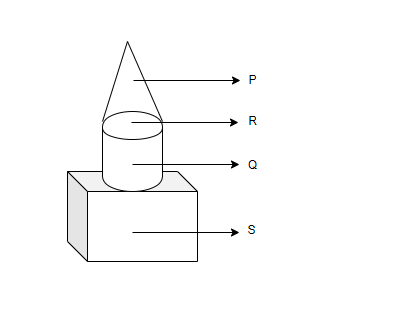
Answer the following questions from the given figure.

Here the solid is composed of cube, cylinder and cone.
Here,
The curved surface area of the cone is P.
The curved surface area of the cylinder is Q.
The area of the base of the cone and cylinder is R and the Total surface area of the cube is S.
Then find the total surface area of solid.
$A$. $P + Q - R + S$
$B$. $P + Q - 2R + S$
$C$. $P + Q + R + S$
$D$. $P + Q + 2R + S$

Answer
584.1k+ views
Hint – Here we will proceed by observing the figure carefully to find out the total surface area of solid. Then by applying the conditions given in the question we will get our answer.
Complete step by step answer:
Here, it is given that-
The curved surface area of the cone is P.
The curved surface area of the cylinder is Q.
The area of the base of cone and cylinder is R
The total surface area of the cube is S.
We have to find the total surface area of solid.
Then, the total surface area of solid is equal to –
Curved surface area of cone + Curved surface area of cylinder – Area of the cone of the cone and cylinder + Total surface area of cube.
That is, P+Q-R+S.
The upper part of the cube that is R (area of the base of the cylinder and cone) gets subtracted because it lies below the cylinder and is covered by it. So it is hidden.
Therefore, the correct option is A.
Note- Whenever we come up with this type of problem, one must know that total surface area is the surface area including the curved surface area and the base area and curved surface area is only the curved surface area excluding the base area. By using these basics, we can easily solve this question.
Complete step by step answer:
Here, it is given that-
The curved surface area of the cone is P.
The curved surface area of the cylinder is Q.
The area of the base of cone and cylinder is R
The total surface area of the cube is S.
We have to find the total surface area of solid.
Then, the total surface area of solid is equal to –
Curved surface area of cone + Curved surface area of cylinder – Area of the cone of the cone and cylinder + Total surface area of cube.
That is, P+Q-R+S.
The upper part of the cube that is R (area of the base of the cylinder and cone) gets subtracted because it lies below the cylinder and is covered by it. So it is hidden.
Therefore, the correct option is A.
Note- Whenever we come up with this type of problem, one must know that total surface area is the surface area including the curved surface area and the base area and curved surface area is only the curved surface area excluding the base area. By using these basics, we can easily solve this question.
Recently Updated Pages
Why is there a time difference of about 5 hours between class 10 social science CBSE

In cricket, what is a "pink ball" primarily used for?

In cricket, what is the "new ball" phase?

In cricket, what is a "death over"?

What is the "Powerplay" in T20 cricket?

In cricket, what is a "super over"?

Trending doubts
What is meant by exothermic and endothermic reactions class 11 chemistry CBSE

Which animal has three hearts class 11 biology CBSE

10 examples of friction in our daily life

One Metric ton is equal to kg A 10000 B 1000 C 100 class 11 physics CBSE

1 Quintal is equal to a 110 kg b 10 kg c 100kg d 1000 class 11 physics CBSE

Difference Between Prokaryotic Cells and Eukaryotic Cells




